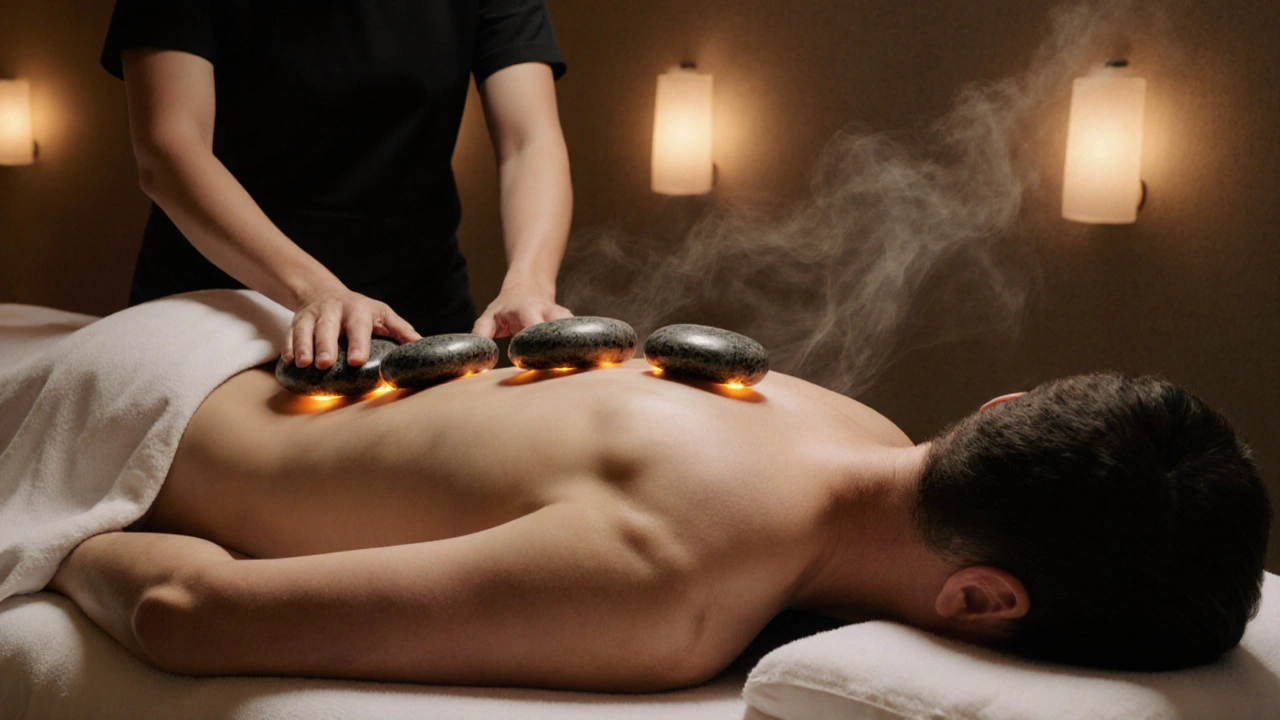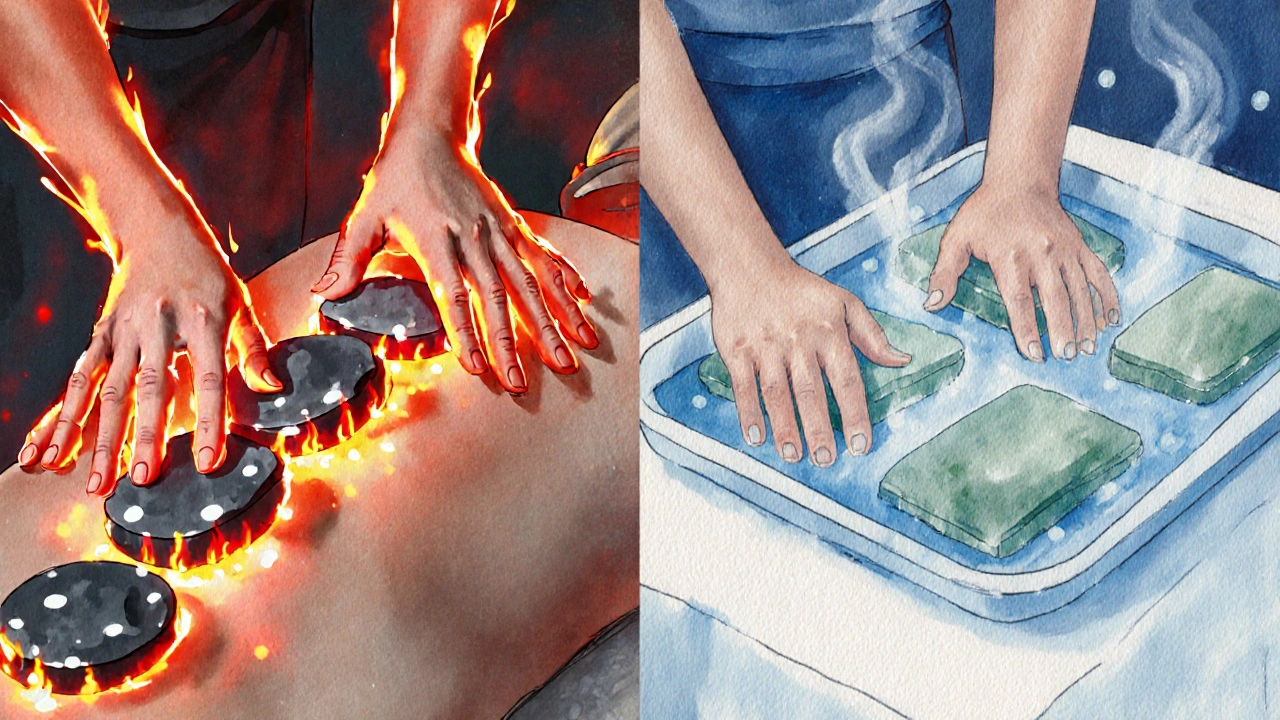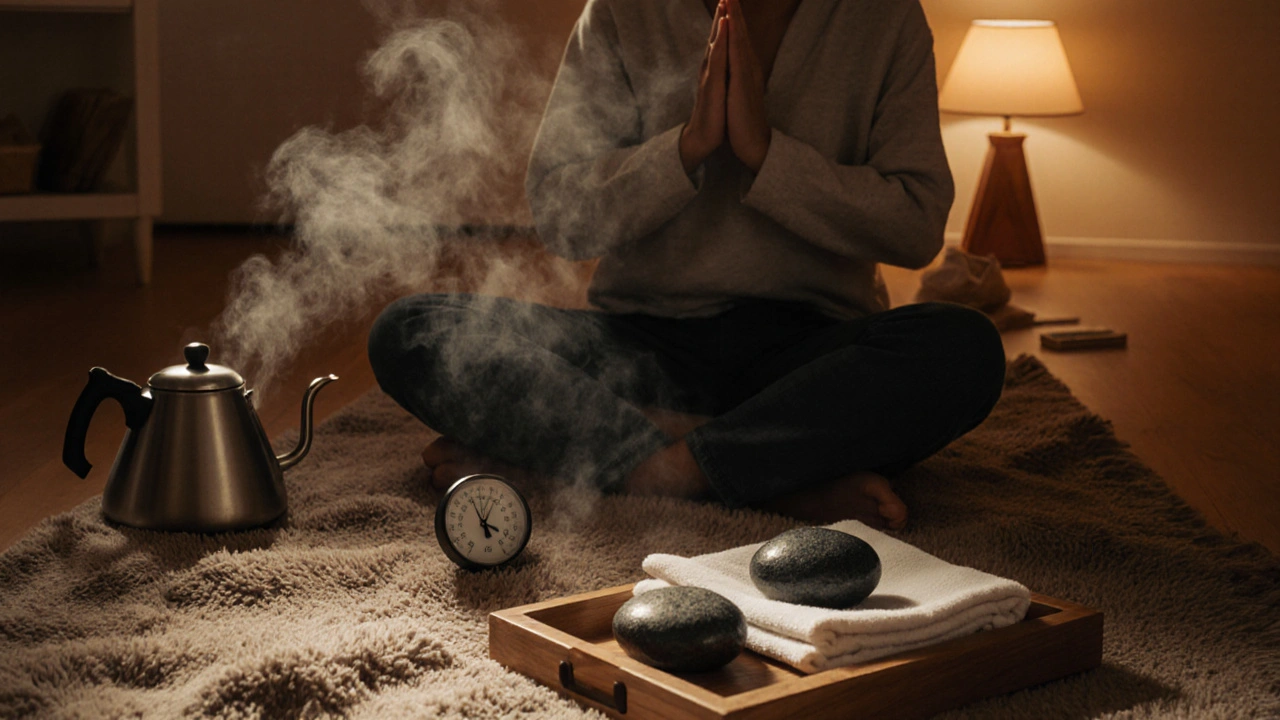Unlock the Healing Benefits of Stone Therapy
 Oct, 14 2025
Oct, 14 2025
Stone Therapy Temperature Calculator
Therapy Settings
Safety Results
Adjust the temperature slider to see safety recommendations.
Safety Tips
• Always test stones on the inside of your wrist first
• Never exceed 30 minutes of continuous contact
• Keep stone temperature below 130°F for safety
• Hydrate before and after therapy
Key Takeaways
- Stone therapy uses heated or cooled stones to relax muscles, boost circulation, and lower stress.
- Basalt and jade are the most common stones because they retain temperature well.
- A typical session lasts 60‑90 minutes and includes a consultation, stone placement, and post‑session care.
- Choose a certified therapist who follows safety guidelines for temperature and hygiene.
- You can recreate gentle benefits at home with a few simple tools and proper precautions.
Imagine lying on a warm table while smooth stones glide across your back, melting tension like butter on toast. That’s the core of Stone Therapy is a hands‑on bodywork that combines the natural heat (or cool) of stones with traditional massage techniques to promote physical and emotional balance.
What Is Stone Therapy?
Stone therapy, often called hot stone massage, traces its roots back to ancient cultures that used heated rocks to soothe sore muscles after long hunts or battles. Modern practitioners adapted the practice in the 1990s, standardising protocols and integrating it into spa menus worldwide.
The therapy relies on two simple principles: temperature transfer and the weight of the stone. When a stone is heated to around 120°F (49°C) and placed on the skin, it gently warms the underlying tissue, encouraging blood vessels to expand. Conversely, cool stones (around 50°F/10°C) can reduce inflammation and numb pain.
How Stone Therapy Works on Your Body
Heat is a proven vasodilator. As the stone’s warmth seeps into muscles, capillaries dilate, allowing more oxygen‑rich blood to flow. This heightened circulation accelerates the removal of metabolic waste, which translates to less stiffness and faster recovery after workouts or injuries.
Beyond the physical, the tactile sensation of a smooth stone stimulates the parasympathetic nervous system, the part of your brain that tells you to relax. Studies from the Journal of Alternative and Complementary Medicine (2023) showed a 30% drop in cortisol levels after a 60‑minute hot stone session.
Types of Stone Therapy and Popular Stones
There isn’t a one‑size‑fits‑all approach. Practitioners choose stones based on their thermal properties and cultural meaning.
- Basalt is a volcanic rock that retains heat for up to 30 minutes, making it ideal for hot stone work.
- Jade stays cooler longer, often used in cold‑stone treatments to calm inflammation.
- Hot stone massage typically uses 4‑6 heated basalt stones placed along the spine, on the palms, and on major muscle groups.
- Cold stone therapy employs chilled jade or marble stones, usually for 10‑15 minutes, targeting swelling after sports injuries.
- Combination sessions blend both, starting with warm stones to loosen tissue, then finishing with cool stones to seal the benefits.

Top Benefits Backed by Research
Whether you’re a chronic pain sufferer or just need a mental reset, stone therapy offers several measurable advantages.
- Pain reduction: A 2022 clinical trial reported a 45% decrease in lower‑back pain scores after eight weekly hot stone sessions.
- Improved circulation: Thermal imaging shows a 20% rise in skin temperature and blood flow in treated areas.
- Stress relief: Participants noted a deeper sense of relaxation compared to Swedish massage, with heart‑rate variability increasing by 15%.
- Enhanced flexibility: Muscle stiffness measurements dropped by 25% after a single 90‑minute session.
- Better sleep: Clients reported falling asleep faster and enjoying more REM cycles on nights following treatment.
What to Expect in a Stone Therapy Session
First‑timers often wonder about the flow of a typical appointment. Here’s a step‑by‑step rundown:
- Consultation (5‑10 mins): Therapist asks about medical history, pain areas, and comfort with heat.
- Preparation (5 mins): Stones are heated in a water‑filled stone heater to 120°F (49°C) or chilled in a refrigerator for cold work.
- Massage foundation (10‑15 mins): A gentle Swedish or deep‑tissue massage prepares the muscles.
- Stone placement (20‑30 mins): Heated basalts are placed on the spine, chest, hands, and legs; the therapist may also glide them using smooth strokes.
- Focused work (15‑20 mins): Therapist kneads around the stones, using the weight to deepen pressure without extra force.
- Cool‑down (5‑10 mins): If a combination treatment, chilled stones are added; otherwise the therapist finishes with a light stretching routine.
- After‑care advice (5 mins): Drink water, avoid hot showers for an hour, and stretch lightly to keep muscles supple.
Most studios recommend 1‑2 sessions per month for maintenance, or weekly visits if you’re addressing a specific injury.
Choosing a Qualified Practitioner
Not every massage therapist can safely perform stone work. Look for the following credentials:
- Certification from a recognized body such as the American Massage Therapy Association (AMTA) or the International Association for Therapists (IAT) in hot‑stone modality.
- Training on stone sanitation, temperature monitoring, and contraindications (e.g., open wounds, severe hypertension, pregnancy).
- Positive client reviews that mention comfort with heat and professional hygiene.
- Use of FDA‑approved stone heaters that display exact temperature.
Ask the therapist how they assess stone temperature before placement; a safe range is 110‑130°F (43‑54°C). If a stone feels too hot, they should test it on the back of their hand first.
DIY Stone Therapy at Home (Safe and Simple)
While a professional session is ideal, you can enjoy a mini‑treatment at home with a few steps:
- Buy two smooth basalt stones (about 2‑3 inches in diameter) from a reputable wellness store.
- Place the stones in a pot of water, heat until they reach 115°F (46°C) - use a kitchen thermometer to check.
- Lay a clean towel on a stable surface, then place the warm stones on your neck, shoulders, and lower back.
- Cover each stone with a thin cotton cloth to protect skin.
- Relax for 15‑20 minutes, doing deep breathing or gentle stretching.
- After the session, sip water and apply a light moisturizer to keep skin hydrated.
Never exceed 30 minutes of contact, and always test the stone temperature on your wrist before applying it to larger areas.

Stone Therapy vs. Other Bodywork Techniques
| Aspect | Stone Therapy | Traditional Massage | Acupuncture |
|---|---|---|---|
| Primary Mechanism | Heat transfer + stone weight | Manual pressure & motion | Insertion of fine needles |
| Typical Session Length | 60‑90min | 30‑60min | 20‑40min |
| Key Benefits | Deep muscle relaxation, improved circulation | Muscle tension relief, flexibility | Pain modulation, hormone regulation |
| Contraindications | Heat‑sensitivity, open wounds, severe cardio issues | Skin infections, recent fractures | Bleeding disorders, pregnancy (certain points) |
| Cost (US, 2025) | $95‑$130 per hour | $70‑$110 per hour | $80‑$120 per session |
These differences help you decide which modality matches your goals. If you crave a blend of heat therapy and massage depth, stone therapy usually edges out the others.
Common Questions and Troubleshooting
Frequently Asked Questions
Is stone therapy safe for people with high blood pressure?
Most practitioners advise against using temperatures above 120°F (49°C) for anyone with uncontrolled hypertension. A mild warm session (110°F) under close monitoring is usually fine, but always disclose your condition during the intake.
Can I combine stone therapy with other treatments like aromatherapy?
Absolutely. Many spas layer essential‑oil diffusers or incorporate a calming lavender massage oil during the stone phase. Just ensure the therapist checks for any oil sensitivities.
How often should I book stone therapy sessions?
For general wellness, once a month maintains benefits. If you’re treating chronic pain, weekly sessions for the first four weeks, followed by a maintenance schedule, work well.
What if a stone feels too hot during the session?
Speak up immediately. Therapists should be ready to adjust temperature, add a cloth barrier, or replace the stone. Never endure prolonged discomfort.
Can I use regular garden rocks instead of basalt or jade?
Avoid rocks that may contain sharp edges, toxins, or uneven heat distribution. Professional-grade basalt or certified jade ensures safety and consistent temperature.
Next Steps: Making the Most of Stone Therapy
Ready to feel the shift? Here’s a quick action plan:
- Search local spas using keywords like “hot stone massage near me” and verify certifications.
- Schedule a 60‑minute introductory session; mention any health concerns ahead of time.
- After the appointment, note how your body feels-energy levels, pain scale, sleep quality.
- If you love the experience, set up a recurring monthly slot and consider pairing it with gentle yoga or stretching.
- For a budget‑friendly boost, try the DIY home method once a week and monitor temperature carefully.
Stone therapy isn’t just a luxury; it’s a science‑backed way to reset your nervous system, improve circulation, and melt away everyday tension. Give it a try and watch how a few warm stones can reshape your wellness routine.
